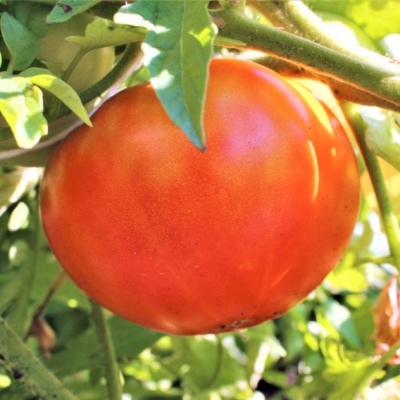
- Category: grade
- Growth type: indeterminate
- Appointment: fresh consumption
- Ripening period: mid-early
- Ripening time, days: 95-105
- Growing conditions: for open ground, for film greenhouses
- Bush size: tall
- Bush height, cm: up to 200
- Bush characteristic: strong, spreading, powerful
- Ripe fruit color: Red
Kum - such an unusual name for tomatoes can be discouraging. But such a plant can become a good helper for any gardener. Knowledge of the peculiarities of culture plays an important role in this.
Description of the variety
Tomato Kum is one of the indeterminate varieties. The crop is suitable for both open ground and greenhouses covered with foil. Kuum bushes can grow up to 2 m. The bushes themselves are outwardly strong. They are characterized by pronounced spreading, 6-8 brushes will appear on 1 plant.
The main qualities of the fruit
Typical features:
red color of ripe berries;
big size;
weight 300-400 g;
flat circle shape;
formation of 5 to 10 tomatoes per brush.
Taste characteristics
Sweet taste is typical for Koum tomatoes. Juicy pulp is hidden under their skin. Although the rind is firm, it does not leave a negative impression.
Ripening and fruiting
This variety belongs to the mid-early group. Fruits can ripen in 95-105 days after the formation of green shoots.
Yield
The possibility of collecting at least 3 kg of fruits on 1 bush is declared. Sometimes it reaches 5 kg of berries. At the same time, productivity per 1 sq. m is capable of reaching 10 kg. It is worth noting that a lot of effort will have to be made for such a result. And also the actual weather plays a significant role.
The timing of planting seedlings and planting in the ground
You can start preparing seedlings in mid-February. The period of sowing seeds in seedling containers will then last until the end of March. It is very important that the planting material is placed in a well-drained potting mix. The optimal time to do this is 63-65 days before the planned transplant to the final place. And the date of the final transplant itself is chosen taking into account the weather and climatic norm.

Growing tomato seedlings is an extremely important process, because it largely depends on whether the gardener can harvest at all. All aspects must be taken into account, from seedbed preparation to planting in the ground.
Landing scheme
For 1 m2, 2 or 3 bushes must be placed. The choice between these options is primarily determined by whether it is necessary to achieve maximum fertility, or optimal care will be in the first place.

Growing and caring
You will have to remove stepchildren from the Kuum bushes in any case. Since these plants grow to a great height, they need to be tied up. Finally, it is also impossible to do without the formation of a tomato shoot. The variety is positioned as suitable mainly for greenhouse cultivation. With this approach, productivity is at least 50% higher than in open gardens.
The seedlings will need to be illuminated for 15-16 hours.Due to the short winter day, this cannot be done without the use of special lamps. At the stage of seedling development, liquid fertilizers such as Agricola are used at least twice. Hardening before disembarkation lasts from 7 to 10 days. When pinching adult bushes, no more than 2 stems are left.
It is necessary to water the plantings 1-2 times a week. This should be done quite abundantly, but without waterlogging. Fertilizers are applied twice a month. The surface of the earth will have to be loosened. The stems are also spud.
Mulching Kum is not very relevant. However, if there is such an intention, then you can use the sawdust after the first watering. Further, as needed, simply add new layers of mulch. In greenhouses, it is useful to use sturdy trellises that can withstand significant loads. It is hardly possible to cultivate such a tomato in open lands north of the middle lane.




A plant needs different micronutrients at each stage of growth. All fertilizers can be divided into two groups: mineral and organic. Folk remedies are often used: iodine, yeast, bird droppings, eggshells.
It is important to observe the rate and period of feeding. This also applies to folk remedies and organic fertilizers.
Disease and pest resistance
This plant is claimed to be able to withstand fruit cracking. Resistance to other pathologies in the middle zone of the Russian Federation and more northern regions has not yet been fully established. Preventive treatments against infection and insect damage will come in handy. It is strongly recommended to disinfect the soil before planting. The use of natural or synthetic remedies is determined by the degree of the disease.


Review overview
Kum grows quite high, while the amicable formation of brushes is noted. The fruits are very large. Some of them are gigantic at all. However, some gardeners find themselves disappointed. At the same time, others note that all characteristics are fully observed.

























































































